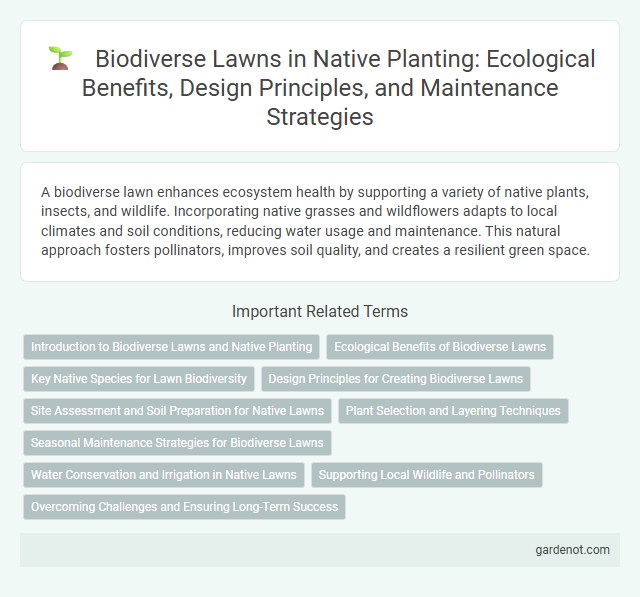A biodiverse lawn enhances ecosystem health by supporting a variety of native plants, insects, and wildlife. Incorporating native grasses and wildflowers adapts to local climates and soil conditions, reducing water usage and maintenance. This natural approach fosters pollinators, improves soil quality, and creates a resilient green space.
Introduction to Biodiverse Lawns and Native Planting
Biodiverse lawns integrate native plant species to create resilient ecosystems that support local wildlife, improve soil health, and reduce water usage. Native planting in biodiverse lawns enhances pollinator habitats by incorporating grasses, wildflowers, and groundcovers indigenous to the region. These lawns contribute to environmental sustainability by promoting biodiversity, reducing chemical inputs, and fostering natural pest control.
Ecological Benefits of Biodiverse Lawns
Biodiverse lawns support native pollinators, improve soil health, and enhance water retention, contributing significantly to local ecosystem resilience. Incorporating native plants fosters habitat for insects, birds, and small mammals, promoting biodiversity and reducing the need for synthetic fertilizers and pesticides. These lawns also mitigate urban heat island effects, making them a sustainable choice for environmentally conscious landscaping.
Key Native Species for Lawn Biodiversity
Key native species such as Buffalo Grass (Bouteloua dactyloides), Blue Grama (Bouteloua gracilis), and White Clover (Trifolium repens) enhance lawn biodiversity by providing essential habitats and food sources for pollinators and beneficial insects. Incorporating these drought-tolerant, low-maintenance grasses supports soil health, reduces water usage, and promotes resilience against pests and diseases. Selecting a diverse mix of native grasses and groundcovers fosters ecosystem balance and encourages local wildlife thriving.
Design Principles for Creating Biodiverse Lawns
Design principles for creating biodiverse lawns emphasize selecting a mix of native grasses, wildflowers, and groundcovers to enhance habitat complexity and support local wildlife. Incorporating plant species with varied bloom times and structural diversity increases pollinator visitation and contributes to soil health and resilience. Maintaining natural lawn cycles, reducing mowing frequency, and avoiding synthetic fertilizers can further promote ecological balance and sustainability.
Site Assessment and Soil Preparation for Native Lawns
Site assessment for biodiverse lawns involves analyzing soil type, moisture levels, sunlight exposure, and native plant species suitability to ensure optimal growth conditions. Soil preparation includes testing pH, improving drainage, incorporating organic matter, and minimizing disturbances to preserve native microorganisms essential for healthy root development. Prioritizing these steps enhances soil fertility and supports a resilient, diverse native lawn ecosystem.
Plant Selection and Layering Techniques
Selecting native grasses, wildflowers, and shrubs enhances biodiversity and supports local pollinators in a biodiverse lawn. Employing layering techniques with groundcovers, mid-height perennials, and taller native plants creates habitat complexity that benefits wildlife. This structured plant arrangement improves soil health, water retention, and resilience against pests.
Seasonal Maintenance Strategies for Biodiverse Lawns
Seasonal maintenance strategies for biodiverse lawns involve targeted mowing techniques that promote native plant growth and enhance habitat diversity throughout the year. Implementing a spring and fall schedule for selective trimming encourages flowering and seed production, supporting pollinators and soil health. Integrating organic mulching and minimal irrigation during dry months sustains native species resilience and reduces invasive weed proliferation.
Water Conservation and Irrigation in Native Lawns
Native lawns, composed of drought-resistant grasses and wildflowers, significantly reduce water usage compared to traditional turf by requiring minimal irrigation. Deep-rooted native plants enhance soil structure and promote efficient rainwater absorption, minimizing runoff and evaporation. These biodiverse lawns support local ecosystems while conserving water resources through natural drought tolerance and reduced maintenance needs.
Supporting Local Wildlife and Pollinators
A biodiverse lawn composed of native plants creates a vital habitat that supports local wildlife and pollinators such as bees, butterflies, and birds. These native species provide essential nectar, pollen sources, and shelter, enhancing ecosystem health and resilience. Incorporating diverse native flora encourages natural pest control and promotes soil health, contributing to a sustainable and vibrant environment.
Overcoming Challenges and Ensuring Long-Term Success
Establishing a biodiverse lawn requires selecting native plant species optimized for local soil, climate, and water availability to overcome initial growth challenges. Implementing proper soil preparation, timely irrigation, and targeted weed control ensures strong root development and reduces invasive species encroachment. Monitoring ecosystem interactions and adapting maintenance practices promote long-term ecological balance and sustainable lawn health.
Biodiverse lawn Infographic

 gardenot.com
gardenot.com